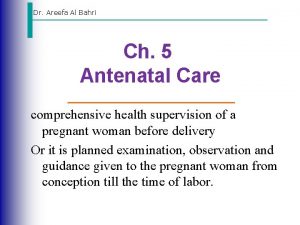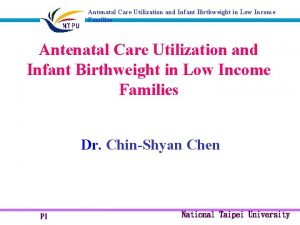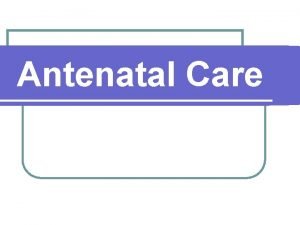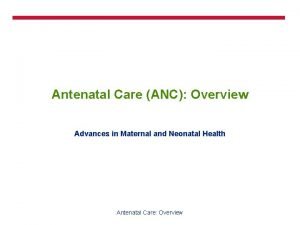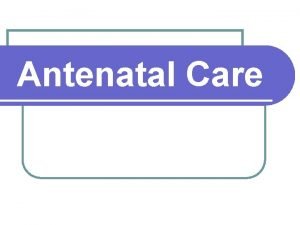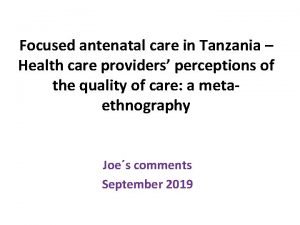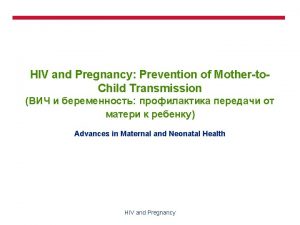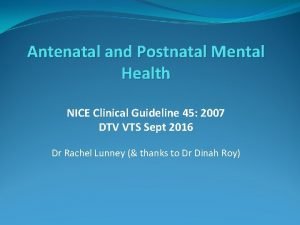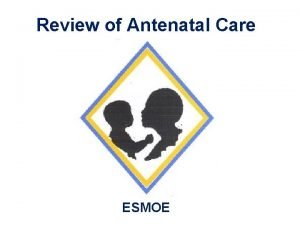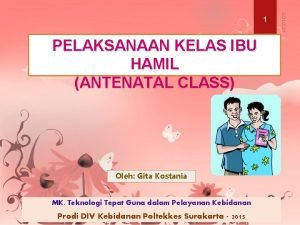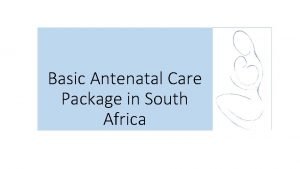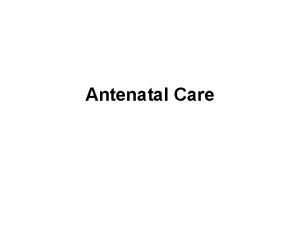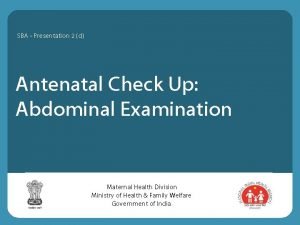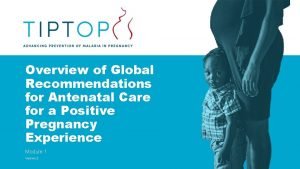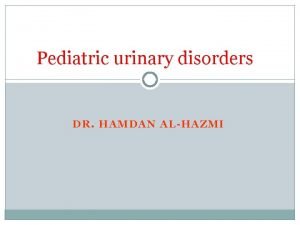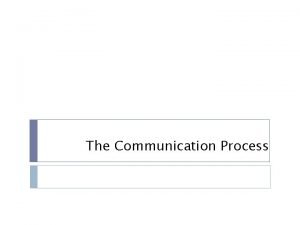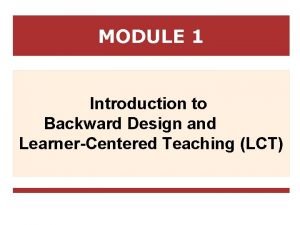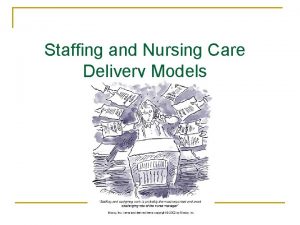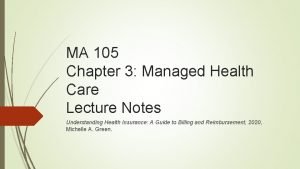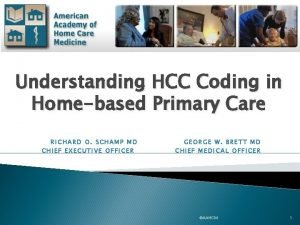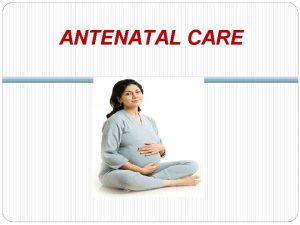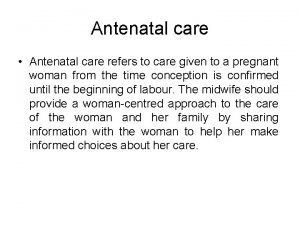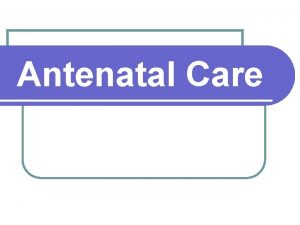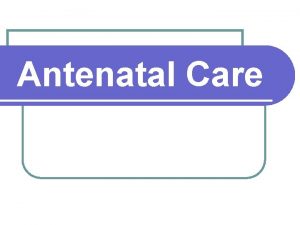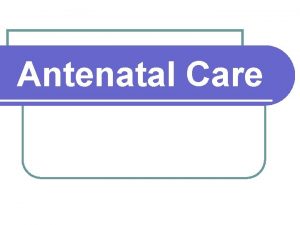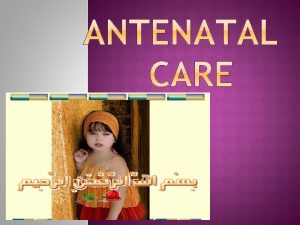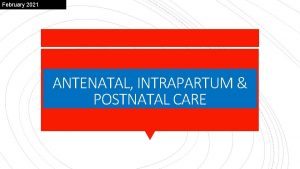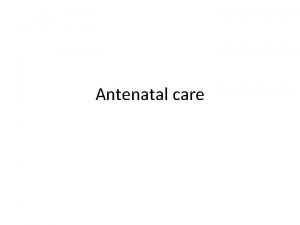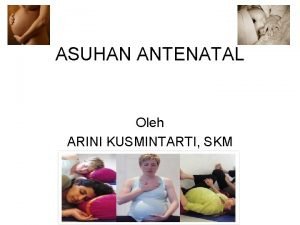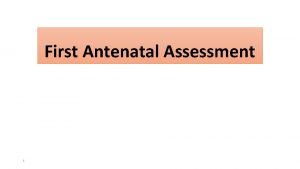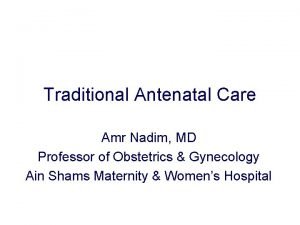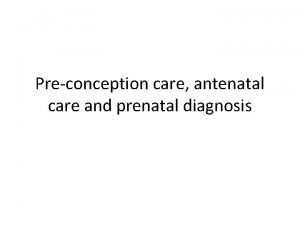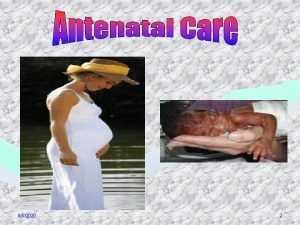TRADITIONAL FOCUSSED AND WHO 2016 ANTENATAL CARE MODELS



























- Slides: 27

TRADITIONAL, FOCUSSED AND WHO 2016 ANTENATAL CARE MODELS DR OLADUNNI E. K

DEFINITION • ANC is an integrated care delivery throughout pregnancy through timely and appropriate evidence based actions related to health promotion, disease prevention, screening and treatment. (WHO) • ANC is the care women receive during pregnancy which helps to ensure healthy outcomes for women and Newborn 10/30/2020 2

EPIDEMIOLOGY Globally, while 86% of pregnant women access antenatal care with skilled health personnel at least once, only 3 in 5 (62%) had at least four antenatal visits. In regions with the highest rates of maternal mortality, such as Sub. Saharan Africa and South Asia, even fewer women had at least four antenatal visits. (52% and 46% respectively). 10/30/2020 3

AIM OF ANC To provide pregnant women with respectful, individualized, person-centred care at every contact, with implementation of effective clinical practices (interventions and tests), and provision of relevant and timely information, and psychosocial and emotional support, by practitioners with good clinical and interpersonal skills within a well functioning health system.

GOALS OF ANC • Early, accurate estimation of gestational age. • Identification of pregnancies at increased risk for maternal or fetal morbidity and mortality. • Ongoing evaluation of maternal and fetal health status. • Anticipation of problems with intervention, if possible, to prevent or minimize morbidity. • Health promotion, education, support and shared decision-making. 10/30/2020 5

THE TRADITIONAL ANC • Began 200 years ago and instituted programmes and interventions that were traditionally thought to benefit the mother and her fetus. • Activities were not scientifically tested as to the effectiveness or benefit. • Lead to up to 14 visits and cost incurred for many investigations that were not necessarily warranted. • There have been suggestions that traditional practice be replaced with new models. 10/30/2020 6

THE ROUTINE/TRADITIONAL ANC • The antenatal period based on high risk and low risk approach • Emphasis on frequent visits For high risk mothers • Till 28 weeks GA: every 4 weeks(5 -6 visits) • Till 36 weeks GA: Every 2 weeks (4 visits) • Till delivery: weekly (4 visits)

FOCUSED ANC (FANC) • Followed large randomized multicenter trials • Identified evidence based interventions and visit patterns that benefitted mothers and their fetus, and were cost effective. • Suggest 4 routine visits only at different gestations with few evidence based diagnostic and interventions modalities performed at each visits. • Additional visits were individualized. 10/30/2020 8

FOCUSED ANC (FANC) • Followed large randomized multicenter trials • Identified evidence based interventions and visit patterns that benefitted mothers and their fetus, and were cost effective. • Suggest 4 routine visits only at different gestations with few evidence based diagnostic and interventions modalities performed at each visits. • Additional visits were individualized. 10/30/2020 9

FANC • Ante natal care that emphasizes quality over quantity of visits. • The approach, focused antenatal care recognizes three key realities: 1. Frequent visits do not necessarily improve pregnancy outcomes, and in developing countries they are often logistically and financially impossible for women to manage and a burden on the healthcare system.

FANC 2. The majority of pregnancies progress without complications. So antenatal care providers must support women with normal pregnancies and help prevent complications. 3. Many women who have risk factors never develop complications, while women without risk factors often do.

FANC • Involves specific evidence-based interventions for all women • Carried out at four critical times • Part of Pregnancy, Childbirth, Postpartum and Newborn Care (PCPNC) • With the FANC model, the 1 st ANC visit occurs before 12 weeks of pregnancy, the second around 26 weeks, the third around 32 weeks, and the fourth between 36 and 38 weeks of gestation. • Thereafter, women are advised to return to ANC at 41 weeks of gestation or sooner if they experience danger signs.

FANC • Prioritizes person-centred health and well-being: ØReducing mortality and morbidity ØProviding respectful care that takes into account woman’s views ØOptimizing service delivery within health systems üA healthy pregnancy for mother and baby (including preventing or treating risks, illness and death) üPhysical and sociocultural normality during pregnancy üEffective transition to positive labour and birth üPositive motherhood (including maternal self-esteem, competence and autonomy)

10/30/2020 14

10/30/2020 15

CHALLENGES OF FANC 1. Political factor: Lack of political will on policy change and implementation of favorable policies on the issue of maternal and neonatal morbidity/mortality and the diversion of state funds needed for infrastructural development to personal usage negatively affected the outcome of maternal and child health services 2. Resistance to change. 3. The attitudes and behaviors of health care providers in ANC clinics, of lack of respect for privacy, confidentiality, and traditional beliefs of the women, may negatively influence the use of ANC as well as maternal and child health services at large. 10/30/2020 16

THE 2016 ANC MODEL • Essential core package of ANC that all pregnant women and adolescent girls should receive • Complement existing WHO guidance on complications during pregnancy 10/30/2020 17

THE 2016 ANC MODEL • The DECIDE framework is a new tool to support evidence-based decision making that allows for assessment of benefits and harms of an intervention, as well as assessment of values, equity, resource use, acceptability and feasibility. 10/30/2020 18

The DECIDE framework Resource use Values Equity • Three technical consultations with guideline development group (October 2015 -March 2016) RECOMMENDATION Benefits and harms Acceptability Feasibility • Collaborative effort between WHO departments, methodologists and different groups of experts

2016 WHO ANC MODEL This GDG(Guideline development group) recommendation was informed by: • Evidence suggesting increased perinatal deaths in 4 -visit ANC model • Evidence supporting improved safety during pregnancy through increased frequency of maternal and fetal assessment to detect complications • Evidence supporting improved health system communication and support around pregnancy for women and families

2016 WHO ANC MODEL • Evidence indicating that more contact between pregnant women and respectful, knowledgeable health care workers is more likely to lead to a positive pregnancy experience • Evidence from High income countries studies indicating no important differences in maternal and perinatal health outcomes between ANC models that included at least eight contacts and ANC models that included 11 to 15 contacts. 10/30/2020 21

2016 WHO ANC MODEL

Contact versus visits • The guideline uses the term ‘contact’ - it implies an active connection between a pregnant woman and a health care provider that is not implicit with the word ‘visit’. • quality care including medical care, support and timely and relevant information • In terms of the operationalization of this recommendation, ‘contact’ can take place at the facility or at community level • be adapted to local context through health facilities or community outreach services • ‘Contact’ helps to facilitate context-specific recommendations • Interventions (such as malaria, tuberculosis) • Health system (such as task shifting)

EARLY USS • In the new WHO ANC guideline, an ultrasound scan before 24 weeks’ gestation is recommended for all pregnant women to: v estimate gestational age v detect fetal anomalies and multiple pregnancies v enhance the maternal pregnancy experience • An ultrasound scan after 24 weeks’ gestation (late ultrasound) is not recommended for pregnant women who have had an early ultrasound scan. • Stakeholders should consider offering a late ultrasound scan to pregnant women who have not had an early ultrasound scan. • Ultrasound equipment can also be used for other indications (e. g. obstetric emergencies) or by other medical departments. 10/30/2020 24

Way forward/ Effective implementation • Health systems approach and strengthening: o Continuity of care o Integrated service delivery o Improved communication with, and support for women o Availability of supplies and commodities o Empowered health care providers § Recruitment and retention of staff in rural and remote areas § Capacity building

WAY FORWARD • Formulation of favorable health policies • Setting attainable benchmarks for antenatal care • Improving supply of human and material resources • Increasing awareness • Quality improvement 10/30/2020 26

THANK YOU
 Ballottement
Ballottement Conclusion on antenatal care
Conclusion on antenatal care Importance of antenatal care
Importance of antenatal care Summary of antenatal care
Summary of antenatal care Antenatal care meaning
Antenatal care meaning Antenatal care definition
Antenatal care definition Antenatal intrapartum and postnatal
Antenatal intrapartum and postnatal Nice antenatal and postnatal mental health
Nice antenatal and postnatal mental health Primary care secondary care tertiary care
Primary care secondary care tertiary care What is the difference between models and semi modal
What is the difference between models and semi modal Fundal height by week
Fundal height by week Antenatal class adalah
Antenatal class adalah Banc plus checklist
Banc plus checklist Antenatal visit according to who
Antenatal visit according to who Leopold maneuvers
Leopold maneuvers 3 weeks pregnant ultrasound
3 weeks pregnant ultrasound Mcug
Mcug Traditional response hierarchy models
Traditional response hierarchy models Backward design vs traditional curriculum models
Backward design vs traditional curriculum models Appraisal health and social care
Appraisal health and social care Functional nursing care delivery model
Functional nursing care delivery model Modular nursing definition
Modular nursing definition Managed care is categorized according to six models
Managed care is categorized according to six models Care coordination models
Care coordination models Care value base health and social care
Care value base health and social care Care certificate standard 3
Care certificate standard 3 Magnetii sunt corpuri care
Magnetii sunt corpuri care Palliative care vs hospice care
Palliative care vs hospice care
